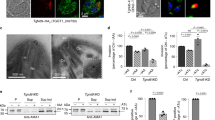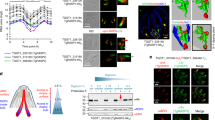Abstract
Intracellular parasites of the phylum Apicomplexa contain specialized rhoptry secretory organelles that have a crucial function in host-cell invasion and establishment of the parasitophorous vacuole. Here we show that localization of the Toxoplasma gondii rhoptry protein ROP2 is dependent on a YEQL sequence in the cytoplasmic tail that binds to µ-chain subunits of T. gondii and mammalian adaptors, and conforms to the YXXφ mammalian sorting motif. Chimaeric reporters, containing the transmembrane domains and cytoplasmic tails of the low-density lipoprotein receptor and of Lamp-1, are sorted to the Golgi or the trans-Golgi network (TGN), and partially to apical microneme organelles of the parasite, respectively. Targeting of these reporters is mediated by YXXφ- and NPXY-type signals. This is the first demonstration of tyrosine-dependent sorting in protozoan parasites, indicating that T. gondii proteins may be targeted to, and involved in biogenesis of, morphologically unique organelles through the use of evolutionarily conserved signals and machinery.
This is a preview of subscription content, access via your institution
Access options
Subscribe to this journal
Receive 12 print issues and online access
$209.00 per year
only $17.42 per issue
Buy this article
- Purchase on Springer Link
- Instant access to full article PDF
Prices may be subject to local taxes which are calculated during checkout









Similar content being viewed by others
References
Joiner, K. A., Fuhrman, S. A., Mietinnen, H., Kasper, L. L. & Mellman, I. Toxoplasma gondii: fusion competence of parasitiphorous vacuoles in Fc receptor transfected fibroblasts. Science 249, 641–646 ( 1990).
Wong, S-Y. & Remington, J. S. Biology of Toxoplasma gondii. AIDS 7, 299–316 ( 1993).
Dubey, J. P. & Beattie, C. P. Toxoplasmosis of Animals and Man. (CRC, Boca Raton, 1988).
Soldati, D. Molecular genetic strategies in Toxoplasma gondii: close in on a successful invader. FEBS Lett. 389, 80–83 ( 1996).
Carruthers, V. B. & Sibley, D. L. Sequential protein secretion from three distinct organelles of Toxoplasma gondii accompanies invasion of human fibroblasts. Eur. J. Cell Biol. 73, 114–123 (1997).
Sam-Yellowe, T. Y. Rhoptry organelles of the Apicomplexa: their role in host cell invasion and intracellular survival. Parasitol. Today 12, 308–316 (1996).
Ngô, H. M., Hoppe, H. C. & Joiner, K. A. Differential sorting and post-secretory targeting of proteins in parasitic invasion. Trends Cell Biol. 10, 67– 72 (2000).
Marks, M. S., Ohno, H., Kirchhausen, T. & Bonifacino, J. S. Protein sorting by tyrosine-based signals: adapting to the Ys and wherefores . Trends Cell Biol. 7, 124– 128 (1997).
Hirst, J. & Robinson, M. S. Clathrin and adaptors. Biochem. Biophys. Acta 1404, 173–193 (1998).
Bonifacino, J. S. & Dell’Angelica, E. C. Molecular bases for the recognition of tyrosine-based sorting signals. J. Cell Biol. 145, 923– 926 (1999).
Chen, W., Goldstein, J. L. & Brown, M. S. NPXY, a sequence often found in cytoplasmic tails, is required for coated pit-mediated internalization of the low density lipoprotein receptor. J. Biol. Chem. 265, 3116– 3123 (1990).
Kibbey, R. G., Rizo, J., Gierasch, L. M. & Anderson, R. G. W. The LDL receptor clustering motif interacts with the clathrin terminal domain in a reverse turn conformation. J. Cell Biol. 142, 59–67 (1998).
Nothwehr, S. F. & Stevens, T. H. Sorting of membrane proteins in the yeast secretory pathway. J. Biol. Chem. 269 , 10185–10188 (1994).
Beckers, C. J. M., Wakefield, T. & Joiner, K. A. The expression of Toxoplasma proteins in Neospora caninum and the identification of a gene encoding a novel rhoptry protein. Mol. Biochem. Parasitol. 89, 209–223 (1997).
Owen, D. J. & Evans, P. R. A structural explanation for the recognition of tyrosine-based endocytic signals. Science 282, 1327–1332 (1998).
Ohno, H., Fournier, M., Poy, G. & Bonifacino, J. S. Structural determinants of interaction of tyrosine-based sorting signals with the adaptor medium chains. J. Biol. Chem. 271, 29009 –29015 (1996).
Karsten, V. et al. The protozoan parasite Toxoplasma gondii targets proteins to dense granules and the vacuolar space using both conserved and unusual mechanisms. J. Cell Biol. 141, 1323– 1333 (1998).
Harter, C. & Mellman, I. Transport of the lysosomal membrane glycoprotein lgp120 (lgp-A) to lysosomes does not require appearance on the plasma membrane. J. Cell Biol. 117, 311– 325 (1992).
Höning, S. & Hunziker, W. Cytoplasmic determinants involved in direct lysosomal sorting, endocytosis, and basolateral targeting of rat lgp120 (lamp-1) in MDCK cells. J. Cell Biol. 128, 321– 332 (1995).
Wimer-Mackin, S. & Granger, B. L. Transmembrane domain mutations influence the cellular distribution of lysosomal membrane glycoprotein A. Biochem. Biophys. Res. Comm. 229, 472–478 (1996).
Reaves, B. J., Banting, G. & Luzio, J. P. Lumenal and transmembrane domains play a role in sorting type I membrane proteins on endocytic pathways. Mol. Biol. Cell 9, 1107–1122 ( 1998).
Munro, S. An investigation of the role of transmembrane domains in Golgi protein retention . EMBO J. 14, 4695–4704 (1995).
Lippincott-Schwartz, J., Yuan, L. C., Bonifacino, J. S. & Klausner, R. D. Rapid redistribution of Golgi proteins into the ER in cells treated with brefeldin A: evidence for membrane cycling from Golgi to ER. Cell 56, 801–813 (1989).
Lippincott-Schwartz, J. et al. Brefeldin A’s effect on endosomes, lysosomes, and the TGN suggest a general mechanism for regulating organelle structure and membrane traffic. Cell 67, 601–616 (1991).
Reaves, B. & Banting, G. Perturbation of the morphology of the trans-Golgi network following brefeldin-A treatment — redistribution of a TGN-specific integral membrane protein, TGN38. J. Cell Biol. 116, 85–94 ( 1992).
Hager, K. M., Striepen, B., Tilney, L. G. & Roos, D. S. The nuclear envelope serves as an intermediary between the ER and golgi complex in the intracellular parasite Toxoplasma gondii. J. Cell Sci. 112, 2631–2638 ( 1999).
Matter, K., Hunziker, W. & Mellman, I. Basolateral sorting of LDL receptor in MDCK cells: the cytoplasmic domain contains two tyrosine-dependent targeting determinants . Cell 71, 741–753 (1992).
Fölsch, H., Ohno, H., Bonifacino, J. S. & Mellman, I. A novel clathrin adaptor complex mediates basolateral targeting in polarized epithelial cells. Cell 15, 189–198 (1999).
Soldati, D., Lassen, A., Dubremetz, J-F. & Boothroyd, J. C. Processing of Toxoplasma ROP1 protein in nascent rhoptries. Mol. Biochem. Parasitol. 96, 37–48 (1998).
Beckers, C. J. M., Dubremetz, J., Mercereau-Puijalon, O. & Joiner, K. A. The Toxoplasma gondii rhoptry protein ROP2 is inserted into the parasitophorous vacuole membrane, surrounding the intracellular parasite, and is exposed to the host cell cytoplasm. J. Cell Biol. 127, 947 –961 (1994).
Shaw, M. K., Roos, D. S. & Tilney, L. G. Acidic compartments and rhoptry formation in Toxoplasma gondii. Parasitology 117, 435– 443 (1998).
Jaikaria, N. S., Rozario, C., Ridley, R. G. & Perkins, M. E. Biogenesis of rhoptry organelles in Plasmodium falciparum. Mol. Biochem. Parasitol. 57, 269–280 ( 1993).
Dittie, A. S., Hajibagheri, N. & Tooze, S. A. The AP-1 adaptor complex binds to immature secretory granules from PC12 cells, and is regulated by ADP-ribosylation factor. J. Cell Biol. 132, 523–536 (1996).
Nesterov, A., Carter, R. E., Sorkina, T. & Sorkin, A. Inhibition of the receptor-binding function of clathrin adaptor protein AP-2 by dominant-negative mutant µ2 subunit and its effect on endocytosis . EMBO J 18, 2489–2499 (1999).
Nakaar, V., Samuel B. U., Ngo, E. O. & Joiner, K. A. Targeted disruption of nucleoside triphosphate hydrolase by antisense RNA inhibits Toxoplasma gondii proliferation. J. Biol. Chem. 274, 5083–5087 (1999).
Sadak, A., Taghy, Z., Fortier, B. & Dubremetz, J-F. Characterization of a family of rhoptry proteins of Toxoplasma gondii. Mol. Biochem. Parasitol. 28, 203–211 (1988).
Ooi, C. E. et al. Altered expression of a novel adaptin leads to defective pigment granule biogenesis in the Drosophila eye color mutant garnet. EMBO J. 16, 4508–4518 ( 1997).
Seymor et al. A candidate gene for the mouse pearl (pe) mutation which affects subcellular organelles. Mol. Biol. Cell 8, (suppl.) 227 (1997).
Swank, R. T., Novak, E. K., McGarry, M. P., Rusiniak, M. E. & Feng, L. Mouse models of Hermansky Pudlak syndrome: a review. Pigment Cell Res. 11, 60– 80 (1998).
Moreno, S. N. J. & Zhong, L. Acidocalcisomes in Toxoplasma gondii tachyzoites. Biochem. J. 313, 655–659 (1996).
Mathews, P. M., Martinie, J. B. & Famrough, D. M. The pathway and targeting signal for delivery of the integral membrane glycoprotein LEP100 to lysosomes. J. Cell Biol. 118, 1027–1040 ( 1992).
Williams, M. A. & Fukuda, M. Accumulation of membrane glycoproteins in lysosomes requires a tyrosine residue at a particular position in the cytoplasmic tail. J. Cell Biol. 111 , 955–966 (1990).
Boman, A. L. & Kahn, R. A. Arf proteins: the membrane traffic police? Trends Biochem. Sci. 20, 147–150 (1995).
Ghosh, R. N., Mallet, W. G., Soe, T. T., McGraw, T. E. & Maxfield, F. R. An endocytosed TGN38 chimeric protein is delivered to the TGN after trafficking through the endocytic recycling compartment in CHO cells. J. Cell Biol. 142, 923–936 (1998).
Voorhees, P. et al. An acidic sequence within the cytoplasmic domain of furin functions as a determinant of trans-Golgi network localization and internalization from the cell surface. EMBO J. 14, 4961–4975 (1995).
Green, S. A. & Kelly, R. B. Low density lipoprotein receptor and cation-independent mannose-6-phosphate receptor are transported from the cell surface to the Golgi apparatus at equal rates in PC12 cells. J. Cell Biol. 117, 47–55 (1992).
Stedman, T. T. & Joiner, K. A. in Advances in Cell and Molecular Biology of Membranes and Organelles (ed. Gordon, S.) Vol 6, 233–261 (JAI, Greenwich, Connecticut, 1999).
Nichols, B. A., Chiappino, M. L. & Pavesio, C. E. N. Endocytosis at the micropore of Toxoplasma gondii . Parasitol. Res. 80, 91– 98 (1994).
Ponnambalam, S., Rabouille, C., Luzio, J. P., Nilsson, T. & Warren, G. The TGN38 glycoprotein contains two non-overlapping signals that mediate localization to the trans-Golgi network. J. Cell Biol. 125, 253–268 (1994).
Karsten, V., Qi, H., Beckers, C. J. M. & Joiner, K. A. targeting the secretory pathway of Toxoplasma gondii. Methods (Orlando) 13, 103–111 ( 1997).
Roos, D. S., Donald, R. G. K., Morrissette, N. S. & Moulton, A. L. C. Molecular tools for genetic dissection of the protozoan parasite Toxoplasma gondii. Methods Cell Biol. 45, 27– 63 (1994).
Ajioka, J. W. et al. Gene discovery by EST sequencing in Toxoplasma gondii reveals sequences restricted to the Apicomplexa. Genome Res. 8, 18–28 (1998).
Morrisette, N. S., Bedian, V., Webster, P. & Roos, D. S. Characterization of the extreme apical antigens from Toxoplasma gondii. Exp. Parasitol. 79, 445–459 ( 1994).
Ohno, H. et al. Interaction of endocytic signals from the HIV-1 envelope glycoprotein complex with members of the adaptor medium chain family. Virology 238, 305–315 ( 1995).
Acknowledgements
This work was supported by Public Health Service Grant ROI AI30060 from the National Institutes of Health and a Scholar Award in Molecular Parasitology from the Burroughs Wellcome Fund to K.A.J., by National Institutes of Health training grant 5T32AI-07404 to H.M.N., by a South African Foundation for Research Development postdoctoral fellowship to H.C.H, and by an individual National Research Service Award 5F32AI-10044 to H.M.N. We thank N. Andrews for critical reading of the manuscript.
Correspondence and requests for materials should be addressed to K.A.J.
Author information
Authors and Affiliations
Corresponding author
Rights and permissions
About this article
Cite this article
Hoppe, H., Ngô, H., Yang, M. et al. Targeting to rhoptry organelles of Toxoplasma gondii involves evolutionarily conserved mechanisms.. Nat Cell Biol 2, 449–456 (2000). https://doi.org/10.1038/35017090
Received:
Revised:
Accepted:
Published:
Issue Date:
DOI: https://doi.org/10.1038/35017090
This article is cited by
-
Eimeria tenella protein trafficking: differential regulation of secretion versus surface tethering during the life cycle
Scientific Reports (2017)
-
Toxoplasma gondii myosin F, an essential motor for centrosomes positioning and apicoplast inheritance
The EMBO Journal (2013)
-
Specific tagging of the egress-related osmiophilic bodies in the gametocytes of Plasmodium falciparum
Malaria Journal (2012)
-
Kiss and spit: the dual roles of Toxoplasma rhoptries
Nature Reviews Microbiology (2008)



